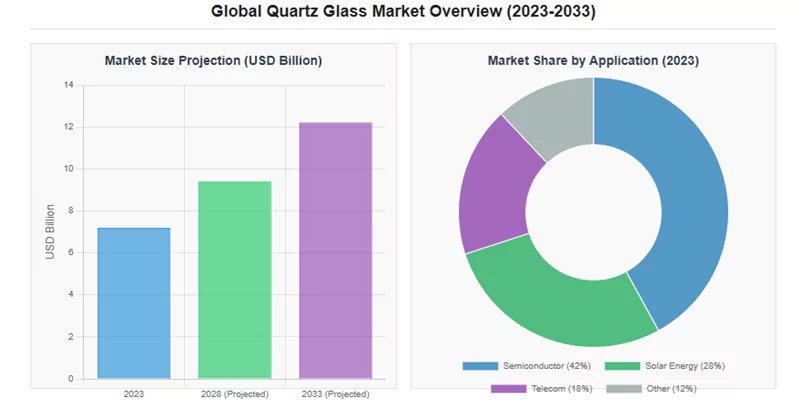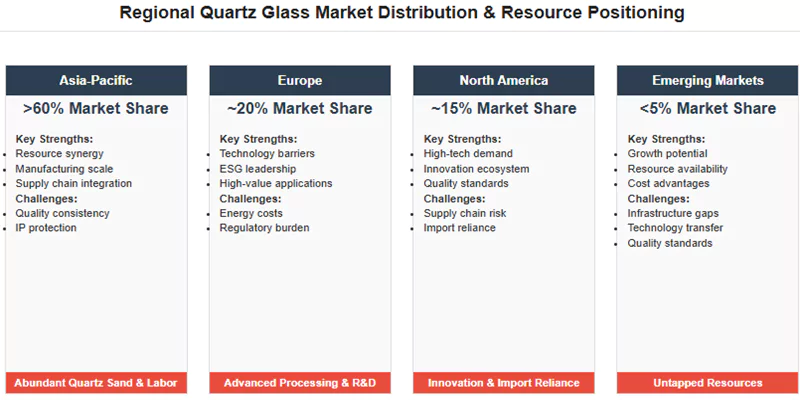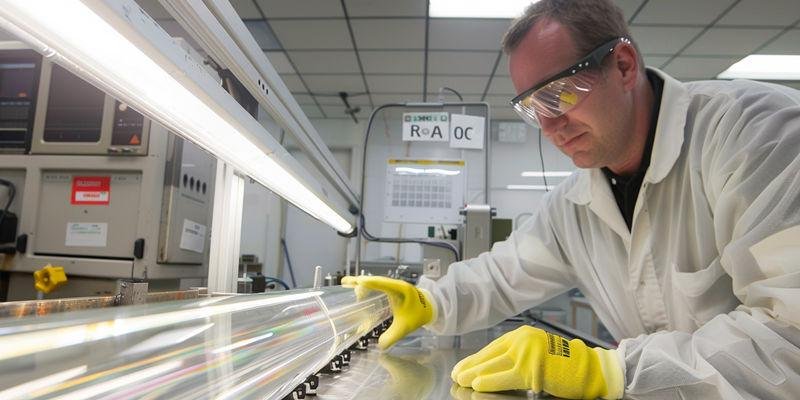Global demand for high-purity quartz glass is rapidly evolving, creating both opportunities and risks for investors.
The quartz glass market covers global production, demand, and value chains for high-purity quartz glass and its variants. Strategic evaluation requires understanding market dynamics, segmentation, regional trends, and actionable investment opportunities.

[References: https://finance.yahoo.com/news/global-quartz-market-size-exceed-190000622.html]
To make informed decisions, business leaders must look beyond headline growth rates and analyze the underlying drivers, product segments, and regional strategies shaping the quartz glass market.
What Defines the Quartz Glass Market and Its Strategic Value in 2025?
Quartz glass market refers to the global ecosystem of production, consumption, and value creation for high-purity quartz glass and its specialized forms.
Quartz glass is a critical material for advanced industries due to its purity, thermal stability, and optical properties. Its strategic value lies in enabling semiconductor manufacturing, photovoltaic energy, and next-generation technologies, making it a focal point for investment and supply chain planning.
Quartz Glass Market Scope and Value Chain
| Segment | Description | Strategic Value |
|---|---|---|
| High-Purity Quartz Glass | Ultra-low impurity, used in semiconductors | Enables advanced chip fabrication |
| Fused Silica | Melting of pure quartz, used in optics/solar | Key for optical and PV applications |
| Synthetic/Specialty Quartz | Tailored for emerging tech (e.g., 5G, lasers) | Supports innovation and differentiation |
| Downstream Applications | Semiconductors, PV, optics, labware, etc. | Drives demand and market expansion |
What Are the Global Market Dynamics and Core Trends Shaping the Quartz Glass Market?
Rapid technological change, energy transformation, and geopolitical shifts are reshaping the quartz glass market landscape.
The market is driven by semiconductor innovation, renewable energy expansion, and evolving global supply chains. Understanding these trends is essential for anticipating demand and identifying growth opportunities.
Key Market Dynamics and Trends
| Trend/Driver | Impact on Market | Example/Context |
|---|---|---|
| Semiconductor Tech Transition | Increases demand for high-purity quartz | 3nm/2nm chip nodes, EUV lithography |
| Energy Transformation | Boosts PV and specialty quartz consumption | Solar panel installations, green tech |
| Geopolitical Supply Chain | Drives regionalization and risk management | US-China trade, resource nationalism |
How Does Semiconductor Technology Transition Drive Quartz Glass Market Demand?
The shift to advanced semiconductor nodes (e.g., 3nm1, EUV2) requires ultra-high-purity quartz for photomasks3, etching, and deposition equipment. As chipmakers invest in new fabs, demand for premium quartz glass rises, making supply security and quality assurance critical.
What Is the Impact of Energy Transformation on Quartz Glass Market Growth?
Global energy transition, especially the growth of solar photovoltaics, increases demand for fused quartz crucibles and tubes used in silicon crystal growth. The push for green energy amplifies the need for reliable, high-purity quartz supply chains.
How Does Geopolitical Supply Chain Restructuring Affect the Quartz Glass Market?
Geopolitical tensions and resource nationalism are prompting countries to localize quartz glass supply chains. This restructuring creates both risks (supply disruptions) and opportunities (regional investment, new entrants) for market participants.
How Is the Quartz Glass Market Segmented by Product and Value?
The quartz glass market is segmented by product type, purity, and end-use value, each with distinct growth trajectories and investment profiles.
Segmentation enables investors to target high-growth niches and align with evolving technology trends.
Quartz Glass Product Segmentation and Value
| Product Segment | Key Features/Specs | Main Applications | Market Share (%) (Est.) |
|---|---|---|---|
| Semiconductor-Grade High-Purity | SiO₂ >99.995%, Fe <0.01 ppm | Chips, photomasks, etching | ~35 |
| Photovoltaic Fused Quartz | Large crucibles, thermal stability | Silicon ingot growth, solar panels | ~30 |
| Specialty Synthetic Quartz | Doped, tailored for tech needs | 5G, lasers, advanced optics | ~20 |
| General/Other | Standard purity, labware, lamps | Laboratory, lighting, misc. | ~15 |
What Is the Market Outlook for Semiconductor-Grade High-Purity Quartz?
Semiconductor-grade quartz is expected to see robust growth, driven by advanced chip manufacturing and the global race for technological leadership. Supply constraints and quality requirements make this segment attractive for strategic investment.
What Is the Growth Potential of Photovoltaic Fused Quartz?
The photovoltaic segment benefits from global solar adoption. Demand for large, defect-free crucibles is rising, with market growth closely tied to solar capacity expansion and silicon wafer production.
How Is Specialty Synthetic Quartz Glass Positioned for Emerging Technologies?
Specialty synthetic quartz serves high-value, niche applications in 5G, laser systems, and advanced optics. Its growth is fueled by innovation cycles and the need for customized material properties.
Which Applications Are Driving High-Growth in the Quartz Glass Market?
Key applications such as semiconductor equipment4, optical communications5, and photovoltaic silicon growth6 are the engines of market expansion.
Identifying these high-growth areas helps investors and suppliers prioritize resources and capture emerging opportunities.

High-Growth Application Segments
| Application Area | Quartz Glass Role | Growth Rate (CAGR, %) | Key Drivers |
|---|---|---|---|
| Semiconductor Equipment | Chambers, tubes, photomasks | 7–9 | Node shrink, fab investments |
| Optical Communication | Fiber preforms, connectors | 6–8 | 5G rollout, data center demand |
| Photovoltaic Silicon Growth | Crucibles, tubes | 8–10 | Solar installations, green energy |
| Analytical/Labware | Cuvettes, plates, reactors | 4–6 | R&D, pharma, diagnostics |
How Does Semiconductor Manufacturing Equipment Influence Quartz Glass Market Expansion?
Semiconductor manufacturing relies on quartz glass for process chambers, tubes, and photomasks. As fabs scale up and adopt new technologies, demand for high-spec quartz components increases, supporting sustained market growth.
What Role Does Optical Communication Infrastructure Play in Quartz Glass Market Growth?
Optical communication infrastructure, including fiber optics and connectors, depends on high-purity quartz preforms. The global rollout of 5G and data centers is driving steady demand for these components.
How Does Photovoltaic Silicon Crystal Growth Accelerate Quartz Glass Market Demand?
Photovoltaic silicon crystal growth uses large quartz crucibles and tubes. As solar installations expand, the need for defect-free, thermally stable quartz products grows, making this a key driver of market demand.
How Do Regional Strategies and Resource Positioning Shape the Quartz Glass Market?
Regional dynamics, resource access, and policy frameworks shape the competitive landscape of the quartz glass market.
Understanding these factors is vital for risk management and strategic investment planning.

Regional Market Positioning and Resource Access
| Region | Market Share (%) | Key Strengths/Challenges | Resource Positioning |
|---|---|---|---|
| Asia-Pacific | >60 | Resource synergy, manufacturing scale | Abundant quartz sand, labor |
| Europe | ~20 | Tech barriers, ESG leadership | Advanced processing, R&D |
| North America | ~15 | High-tech demand, supply chain risk | Import reliance, innovation |
| Emerging Markets | <5 | Growth potential, infrastructure gaps | Untapped resources |
Why Does Asia-Pacific Dominate the Quartz Glass Market and What Are Its Resource Synergies?
Asia-Pacific leads due to abundant quartz resources, integrated supply chains, and large-scale manufacturing. Regional policies and investments further reinforce its dominance.
How Do Euro-American Technology Barriers Affect Quartz Glass Market Access?
Europe and North America maintain high entry barriers through advanced processing technologies, strict quality standards, and ESG requirements. These factors limit market access for new entrants but create opportunities for high-value, compliant suppliers.
What Opportunities Exist in Emerging Quartz Glass Markets?
Emerging markets offer growth potential through untapped resources and rising local demand. Strategic partnerships and infrastructure investments can unlock new market segments.
What Are the Key Supply Chain Security and ESG Compliance Factors in the Quartz Glass Market?
Supply chain security and ESG (Environmental, Social, Governance) compliance are increasingly critical for market participants.
Addressing these factors reduces risk, enhances reputation, and aligns with global customer expectations.
Supply Chain Security and ESG Factors
| Factor | Description | Strategic Importance |
|---|---|---|
| High-Purity Quartz Sand Autonomy | Local control over raw materials | Reduces supply disruption risk |
| Green Electricity Smelting | Use of renewable energy in production | Lowers carbon footprint, ESG value |
| TEL Certification Pathways | Fast-track equipment/material approval | Accelerates market entry |
How Does High-Purity Quartz Sand Autonomy Impact Supply Chain Security?
Local autonomy over high-purity quartz sand ensures stable supply and reduces exposure to geopolitical risks. Vertical integration is a key strategy for leading producers.
What Is the Role of Green Electricity Smelting in Quartz Glass Market Cost Models?
Using green electricity in quartz glass smelting lowers carbon emissions and can reduce long-term energy costs. ESG-conscious buyers increasingly favor suppliers with renewable energy credentials.
How Do Accelerated TEL Certification Pathways Influence Market Entry?
Faster TEL (Tool Equipment List) certification enables quicker adoption of new quartz glass products in semiconductor fabs, shortening time-to-market and enhancing competitiveness.
What Are the Competitive Strategy and Investment Mapping Frameworks for the Quartz Glass Market?
Strategic investment and competitive positioning are essential for capturing value in the evolving quartz glass market.
A structured approach helps identify technology moats, acquisition targets, and material risk factors.
Competitive Strategy and Investment Mapping
| Strategy/Target | Description | Investment Rationale |
|---|---|---|
| Technology Moat Investments | Focus on IP, process know-how, automation | Defensible market position |
| Regional Leader Acquisitions | Acquire top players in key regions | Market share, resource access |
| Alternative Material Risk | Assess threats from substitutes (e.g., ceramics, sapphire) | Future-proofing, diversification |
What Are the Technology Moat Investment Targets in the Quartz Glass Market?
Investing in companies with proprietary technology, advanced automation, and strong IP portfolios creates defensible market positions and long-term value.
Where Are the Regional Leader Acquisition Opportunities in the Quartz Glass Market?
Acquiring regional leaders provides immediate market access, resource control, and established customer bases. Asia-Pacific and Europe are key regions for such opportunities.
How Should Alternative Material Risks Be Assessed in Quartz Glass Market Strategy?
Evaluating risks from substitute materials (e.g., ceramics, sapphire) is essential for strategic planning. Diversification and continuous innovation help mitigate these risks.
Conclusion
Strategic evaluation of the quartz glass market requires a holistic view of trends, segmentation, regional dynamics, and actionable investment frameworks.
Navigating the complexities of the quartz glass market presents a significant challenge for decision-makers. Leverage the expertise of TOQUARTZ’s engineering team, backed by 20+ years of manufacturing experience and direct factory supply, to access tailored market insights and custom quartz glass solutions for your business growth.
FAQ (Frequently Asked Questions)
What are the main growth drivers in the quartz glass market?
Key growth drivers include semiconductor technology advancements, renewable energy expansion, and increasing demand for high-purity materials in emerging technologies.
How can companies manage supply chain risks in the quartz glass market?
Companies should prioritize local resource autonomy, invest in ESG compliance, and build partnerships with reliable suppliers to reduce disruption risks.
What factors should investors consider when evaluating quartz glass market opportunities?
Investors should analyze product segmentation, regional strategies, technology barriers, and alternative material risks to make informed decisions.
How does ESG compliance impact quartz glass market competitiveness?
ESG compliance enhances reputation, meets customer expectations, and can provide access to premium markets, making it a key differentiator for suppliers.
Learn how 3nm technology is revolutionizing chip performance and efficiency, and why it's crucial for the future of advanced electronics. ↩
Learn how EUV lithography enables smaller, more powerful chips and why it's crucial for the latest semiconductor technologies. ↩
Learn how photomasks are essential for creating precise patterns on semiconductor wafers, a key step in advanced chip production. ↩
Exploring this link will provide insights into cutting-edge technologies driving the semiconductor industry. ↩
This resource will enhance your understanding of how optical communications are revolutionizing data transmission. ↩
Learn how advancements in photovoltaic silicon growth drive solar panel efficiency and shape the future of renewable energy solutions. ↩





